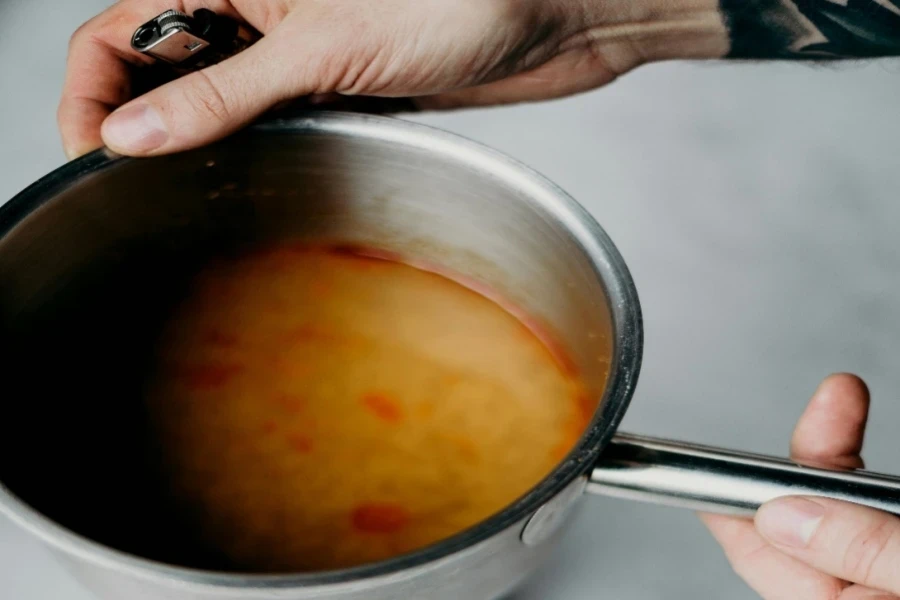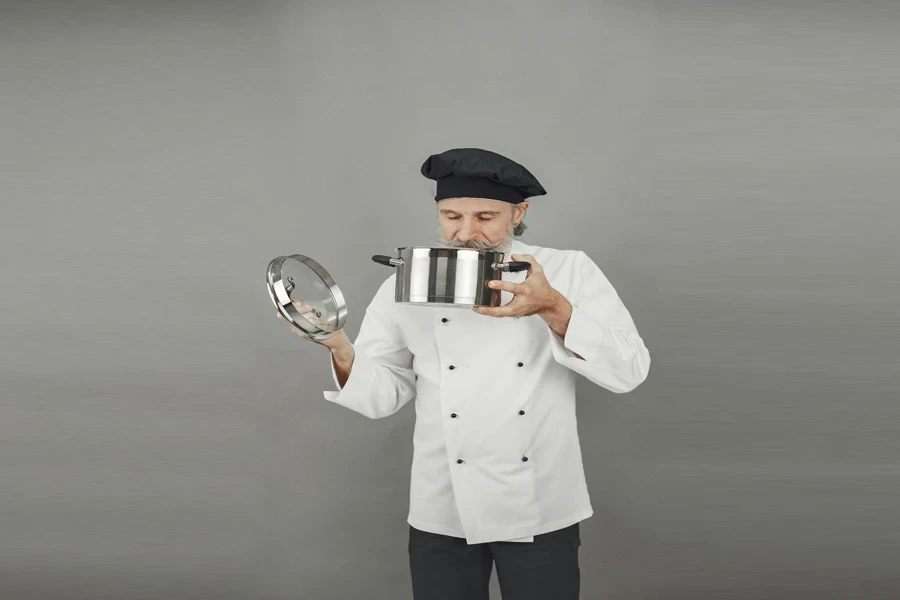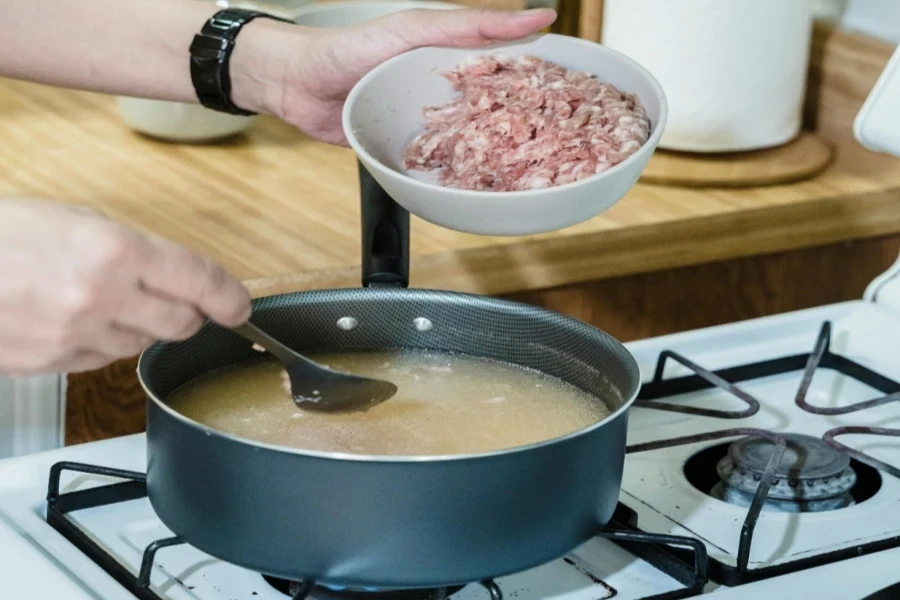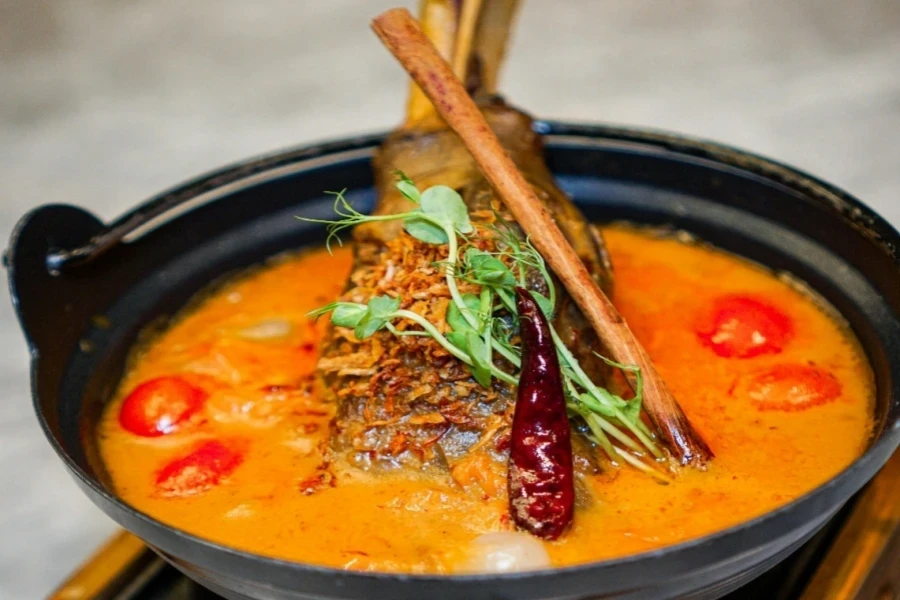Table of Contents
• Introduction
• Market overview
• Different types and their features
• Things to consider when selecting products
• Conclusion
Introduction

Soup and stock pots are essential kitchen tools, providing versatility for cooking a variety of dishes, including soups, stocks, and stews. This guide delves into the latest market trends, highlighting the growth and key players in the industry. It offers an in-depth analysis of different types of pots, their features, and benefits. Additionally, the guide provides crucial considerations for selecting the ideal pot to meet specific culinary needs. Understanding these factors will help businesses make informed decisions when choosing the ideal soup and stock pots for their customers’ kitchens.
Market overview

Market scale and growth
The global soup market is experiencing steady growth, with the market size valued at USD 19.83 billion in 2023. This market is projected to reach USD 27.15 billion by 2033, growing at a compound annual growth rate (CAGR) of 3.19% from 2023 to 2033. The increasing demand for convenience foods, along with the rising awareness of health benefits associated with soup consumption, are key factors driving this growth. Innovative packaging solutions that enhance product convenience and appeal are also contributing significantly to market expansion.
Regional insights
Regional insights reveal that North America currently holds the largest share of the global soup market, driven by a strong preference for ready-to-eat meals among consumers with busy lifestyles. Europe is expected to grow at the fastest pace during the forecast period, with countries like the UK and Russia leading the consumption. The European market is benefiting from the introduction of new products and flavors that cater to diverse consumer preferences. The trend towards healthier eating and the increasing popularity of plant-based diets are further fueling growth in this region.
Key market drivers
Key market drivers include the rising demand for health and wellness products, which has led to an increase in the variety and availability of soup products that cater to specific dietary needs. The convenience factor, particularly the availability of soups in microwavable and easy-to-use packaging, is also a major contributor to market growth. Additionally, the growing female workforce and the consequent need for quick and nutritious meal options are driving the global soup market forward.
Different types and their features

Stainless steel
Stainless steel stock pots are highly valued for their durability and resistance to corrosion. They often feature a multi-layer base, typically composed of an aluminum or copper core sandwiched between stainless steel layers, enhancing heat conduction and distribution. The 18/10 stainless steel composition, meaning 18% chromium and 10% nickel, provides superior resistance to rust and corrosion while maintaining a shiny finish. These pots are non-reactive, making them ideal for cooking acidic foods, and can withstand high temperatures, making them suitable for a variety of cooking tasks.
Enameled steel
Enameled steel stock pots are constructed with a steel base coated in a layer of enamel, which provides a non-reactive, smooth cooking surface. This enamel coating is fused to the steel at high temperatures, creating a durable and easy-to-clean surface. However, the enamel can chip if subjected to rough handling or sudden temperature changes. These pots are generally lighter than their cast iron counterparts and come in a variety of colors and designs, making them aesthetically pleasing additions to any kitchen. They are suitable for boiling, simmering, and preparing simple dishes.
Enamelled cast iron
Enamelled cast iron pots combine the heat retention properties of cast iron with a non-reactive enamel coating. The enamel layer prevents rusting and eliminates the need for seasoning, typical of traditional cast iron cookware. These pots can maintain steady low-to-medium heat, making them ideal for slow cooking, stews, and braising. The thick walls and heavy base provide even heat distribution, but the weight can be cumbersome. Enamelled cast iron is compatible with all cooktops, including induction, and can also be used in the oven, offering versatility for various cooking methods.
Copper
Copper stock pots are renowned for their excellent thermal conductivity, which is significantly higher than stainless steel and aluminum. This allows for precise temperature control and quick heating and cooling. Typically, copper pots are lined with a layer of stainless steel to prevent reactions with acidic foods, while maintaining the superior heat properties of copper. These pots often feature a polished exterior, requiring regular maintenance to keep their shine. Copper’s superior conductivity makes these pots ideal for tasks that require precise heat control, such as delicate sauces and temperature-sensitive dishes.
Hard-anodized aluminum
Hard-anodized aluminum pots undergo an electrochemical process that hardens the aluminum surface, making it more durable and resistant to scratches and corrosion. This process also makes the aluminum non-reactive, allowing for the cooking of acidic foods without altering flavors. These pots offer excellent heat distribution and retention, and their non-stick surface facilitates easy cleaning. Hard-anodized aluminum is lighter than cast iron but retains similar heat retention properties, making it suitable for high-temperature cooking and oven use.
Nonstick
Nonstick stock pots are typically made from aluminum or stainless steel coated with a nonstick material, such as polytetrafluoroethylene (PTFE) or ceramic. This coating prevents food from sticking, making cleaning easier and reducing the need for cooking oils. Nonstick pots are ideal for low to medium heat cooking but can be damaged at high temperatures or with the use of metal utensils. The nonstick coating’s lifespan depends on the quality of the coating and how well the pot is maintained. These pots are particularly useful for cooking delicate foods like eggs, fish, and certain types of sauces that are prone to sticking.
Things to consider when selecting products

Size and capacity
When selecting a stock pot, the size and capacity are crucial considerations. For home use, a common range is between 6 to 12 quarts, which is sufficient for preparing meals for a family. A 6-quart pot can handle soups and stews for small gatherings, while a 12-quart pot is ideal for larger batches or cooking pasta. In commercial settings, larger sizes ranging from 20 to 60 quarts are necessary. These larger pots accommodate high-volume cooking requirements, such as making stocks for restaurants or catering services. For example, a 20-quart pot is ideal for boiling large quantities of seafood, whereas a 60-quart pot can handle extensive soup preparation or brewing beer.
Material and construction
The material and construction of a stock pot significantly impact its performance and durability. Stainless steel, especially 18/10 stainless steel, is a popular choice due to its excellent resistance to rust and corrosion, and its ability to withstand high temperatures without warping. It often features a multi-layered base with an aluminum or copper core for enhanced heat conductivity and distribution. This construction ensures that heat spreads evenly across the bottom and up the sides of the pot, preventing hot spots and ensuring consistent cooking.
Hard-anodized aluminum is another excellent choice, offering twice the hardness of stainless steel. This material undergoes an electrochemical process that creates a durable, non-reactive surface, resistant to scratches and dents. Hard-anodized pots often feature non-stick coatings that simplify cleaning and reduce the need for excessive oil during cooking. Tri-ply and multi-clad pots combine layers of aluminum or copper between stainless steel layers, providing superior heat conduction and retention. These pots are designed to handle both stovetop and oven use, making them versatile additions to any kitchen.
Design and features
The design and features of a stock pot can greatly enhance its functionality and safety. Handles are a critical component; they should be ergonomically designed and securely attached with rivets for maximum stability. Look for pots with heat-resistant handles that stay cool to the touch, reducing the risk of burns. Some pots feature silicone-wrapped handles, which provide additional grip and comfort.
Lids are another important feature. A tight-fitting lid helps retain heat and moisture, essential for cooking soups and stews. Vented lids are particularly useful as they allow steam to escape, preventing the pot from boiling over. The bottom thickness of a stock pot is also crucial; a thick, heavy bottom ensures even heat distribution and prevents scorching, especially during prolonged cooking.
Graduated markings on the interior of the pot can be a valuable feature for precise measurement of liquids. Flared rims facilitate easy pouring, reducing spills and making it easier to transfer liquids without mess. Some high-end models also include features like induction compatibility, ensuring the pot can be used on various cooktop surfaces, including induction, gas, and electric stoves.
Budget
Budget considerations are essential when choosing a stock pot. For those looking for cost-effective options, aluminum and basic stainless steel pots offer good performance at a lower price point. These pots are generally lightweight and heat up quickly, though they may lack the durability and heat distribution efficiency of higher-end models.
Investing in higher-end options such as copper or multi-clad stainless steel can provide significant benefits. Copper pots, known for their exceptional thermal conductivity, offer precise temperature control, making them ideal for delicate cooking tasks. Multi-clad stainless steel pots, with their layered construction, provide excellent heat retention and even cooking. These high-end pots are more durable and can withstand the rigors of professional kitchens, justifying their higher cost.
Conclusion

Selecting the right soup and stock pot is essential for achieving efficient and enjoyable cooking results. Understanding the latest market trends, the various types of pots available, and their specific features helps in making an informed decision. Considering factors such as size, material, construction, design, and budget ensures that the chosen pot meets specific culinary needs and preferences, ultimately enhancing the cooking experience and delivering superior outcomes in both home and professional kitchens.




